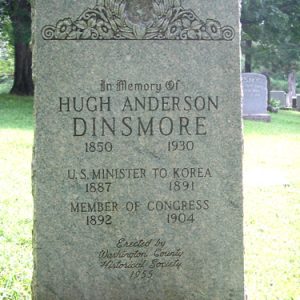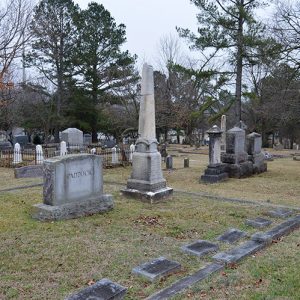calsfoundation@cals.org
Evergreen Cemetery
Burials in the historic Evergreen Cemetery in Fayetteville (Washington County) form a “who’s who” of state and local history, including one early governor, four members of Congress, a state Supreme Court judge, several former presidents of the University of Arkansas (UA) in Fayetteville, and a famous architect. This cemetery also contains the graves of town founders, private citizens, and those whose names are unknown.
Evergreen is located at the corner of West Center Street and North University Avenue, near UA. It began in the 1840s as the private burial ground of the John Thomas family, on what was then their farm. In the twenty-first century, it comprises more than ten acres and holds an estimated 3,000 burials. In 1870, Washington Lodge No. 1 of the Free and Accepted Masons and Lodge No. 15 of the Independent Order of Odd Fellows purchased the property in order to establish a cemetery for their members and the public.
Prior to the establishment of public cemeteries, families living in the Fayetteville area buried on their own property. Some of these burials were eventually moved to Evergreen. One such reburial was that of early educator Sophia Sawyer (1792–1854), originally interred on the grounds of her Fayetteville Female Seminary. In 1872, U.S. congressman and second governor of the state Archibald Yell (1797–1847), who had been killed during the Mexican War, was reinterred in Evergreen Cemetery after having originally been buried in Mexico and then in the yard of his Fayetteville home. Graves of the entire Yell family were moved to a plot donated by the Masons.
A city map drawn in 1884 shows one-quarter of the cemetery reserved for public burials. In 1885, Hugh F. Reagan, chairman of the Odd Fellows’ committee to investigate the sale of burial plots, used Masonic records, information provided by the sexton, and his own enumeration of graves to produce an accounting of all known graves and plot sales. (It is likely this report that caused Sophia Sawyer to be erroneously deemed Evergreen’s “first recorded burial.”) It lists the owners of family plots, plots set aside for the use of the two fraternal orders, five plots reserved—but not paid for—by what was then Arkansas Industrial University (now UA), as well as paupers’ burials. In 1915, the two fraternal lodges deeded the grounds to the Evergreen Cemetery Association, made up of local citizens. This was incorporated as the Fayetteville Evergreen Cemetery Association in 1925.
J. William Fulbright (1905–1995) is one of the cemetery’s most illustrious occupants, having served as president of UA, member of the U.S. House of Representatives, and member of the U.S. Senate. Other family members buried there include Fulbright’s mother, Roberta Waugh Fulbright (1874–1953), who took over control of her husband Jay Fulbright’s many business interests, including publishing the Fayetteville Daily Democrat, following his death in 1923.
Other members of Congress buried at Evergreen are Thomas Montague Gunter (1824–1904), a colonel in the Thirteenth Regiment, Arkansas Volunteers (Confederate) and member of the U.S. House of Representatives for Arkansas; Hugh A. Dinsmore (1850–1930), who was appointed by President Grover Cleveland as minister to Korea and served as a member of the U.S. House of Representatives for Arkansas; and John N. Tillman (1859–1929), U.S. representative who also served as president of UA.
The ashes of architect Edward Durell Stone (1902–1978) are interred in Evergreen. Writer John Tate Appleby (1907–1974)—better known in England, especially for his book Suffolk Summer (1948)—is buried alongside family members. Sports figures include bantamweight boxer Thomas B. “Trigger” Holt (1900–1941) and two major league baseball players: Roy Wood (1892–1974)—who played for the Pittsburgh Pirates, Cleveland Naps, and Cleveland Indians—and Sid Benton (1894–1977), who pitched just one game for the St. Louis Cardinals.
Former slave Adeline Blakeley (1850–1945), interviewed by the Works Progress Administration Writers’ Project, is Blakeley-Hudgins plot. Because the cemetery was for whites only, the Blakeley family hoped to avoid local opposition, but the event was hardly a secret. Blakeley’s obituary reported that “a large crowd of white friends” paid their respects, listing her pallbearers as six prominent white businessmen, two of whom were cemetery board members, as was Helen (Hudgins) Wiggans, great-granddaughter of Blakeley’s original owner and the family member who made the funeral and burial arrangements.
Three members of the Basore family are buried there, victims of a mass murder committed by a family member in 1971, one that claimed five lives (including the killer’s).
Nearby are horticulturalist Henry Martin Stringfellow (1839–1912) and wife Alice Stringfellow (1845–1942). Following the death of their twenty-year-old son Leslie in 1886, the couple supposedly communed with him through automatic writing using a planchette. Alice Stringfellow later corresponded with fellow spiritualist Sir Arthur Conan Doyle and, at his urging, published Leslie’s letters describing heaven. The couple adopted a daughter in 1897, Lessie Stringfellow Read (1891–1971), who became a noted journalist and women’s rights champion; she is also buried in the Stringfellow plot.
Though Evergreen contains few examples of grand, imported monument styles found in cemeteries in larger cities, one marker is of note. An immense zinc obelisk marks the family plot of Lafayette Gregg (1825–1891), a colonel in the Fourth Regiment, Arkansas Federal Cavalry Volunteers, and later an associate justice on the Arkansas Supreme Court. This obelisk, part of a short-lived fad for white bronze (actually zinc), was cast by Detroit Bronze Company and extensively vandalized in the 1990s. The monument was restored by sculptor Hank Kaminsky in 2004, who recast an exact duplicate of the monument’s upper portion in aluminum.
Over the years, neglect and vandalism (in at least one instance perpetuated by UA fraternity members) resulted in damaged or stolen headstones. Burial records are incomplete, and not all graves were ever marked, making it difficult to ascertain the names of all burials. In 2001, UA professor Greg Vogel, teaching a class on archaeological methods, initiated the Evergreen Cemetery Recording Project, in which his students photographed, sketched, measured, and recorded Evergreen’s oldest monuments, and mapped the grounds. Community volunteers later joined the project.
Evergreen Cemetery, placed on the National Register of Historic Places in 1997, remains a private, nonprofit cemetery managed by a board of directors.
For additional information:
Chism, Stephen. The Afterlife of Leslie Stringfellow: A Nineteenth-Century Southern Family’s Experiences with Spiritualism. Fayetteville: University of Arkansas Press, 2005.
“Evergreen Cemetery.” National Register of Historic Places nomination form. On file at Arkansas Historic Preservation Program, Little Rock, Arkansas.
Fayetteville Evergreen Cemetery Association Records. Special Collections. University of Arkansas Libraries, Fayetteville, Arkansas.
“Funeral Service Held For Adeline Blakeley.” Northwest Arkansas Times, May 15, 1945, p. 5.
“Gunfire Claims Five Members of Family.” Northwest Arkansas Times, September 6, 1971, p. 1A.
Lemke, W. J. “The Beginnings of Evergreen.” Flashback 1 (August 1951): 13–19.
Water, Annie Thomas. “My Paternal Grandfather—Washington Wilson.” Flashback 5 (February 1955): 15–18.
Abby Burnett
Kingston, Arkansas
 Civil War through Reconstruction, 1861 through 1874
Civil War through Reconstruction, 1861 through 1874 Historic Preservation
Historic Preservation Hugh Dinsmore's Tombstone
Hugh Dinsmore's Tombstone  Evergreen Cemetery
Evergreen Cemetery  Evergreen Cemetery
Evergreen Cemetery  Evergreen Cemetery
Evergreen Cemetery 




Comments
No comments on this entry yet.